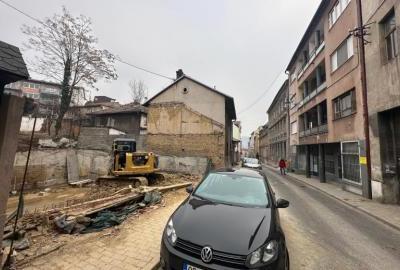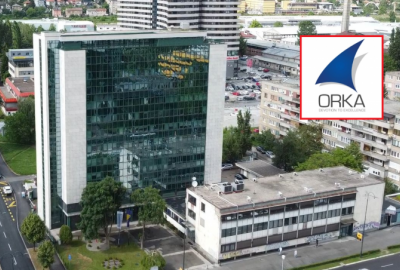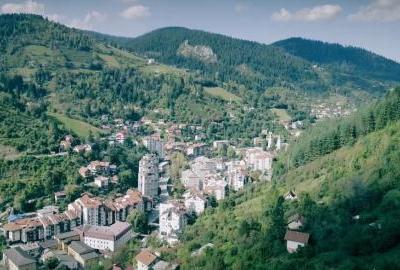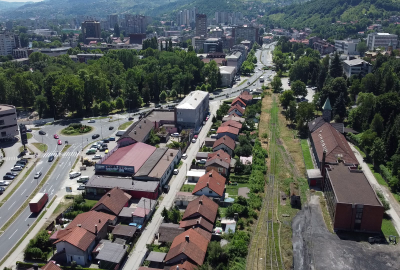Žurnal in English
Where do 211.000 tons of garbage end up: Illegal landfills pollute the air, water and spoil, causing serious illness in local residents
Omer Hujdur states that the situation at the Uborak landfill is becoming increasingly difficult, noting that the connection between the landfill and the rise in cancer rates has been apparent for a long time. Safet Kubat explains that illegal landfills are often a major source of drinking water contamination through leachate. The Center for the Environment has reported numerous instances of illegal and improperly managed landfills across the country, from Omačina to Drvar.
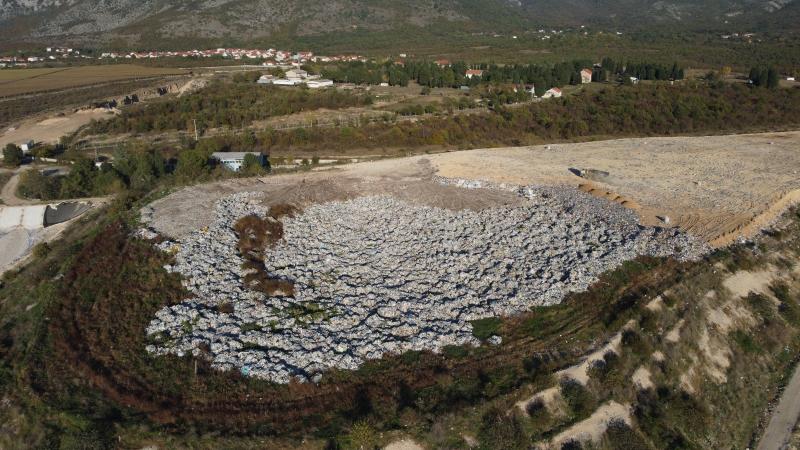
Uborak landfill in Mostar has been posing a serious environmental and health hazard to the local population for years. Despite repeated appeals and calls for its closure and relocation, the authorities have remained silent on this pressing issue. While the municipal waste disposal site continues to pollute the environment, residents of the surrounding areas face numerous health risks, including a rise in cancer and other serious diseases.
Omer Hujdur from the Citizens’ Initiative “Jer nas se tiče” (Because it concerns us) told Žurnal that the situation is becoming increasingly dire. A recent video they received shows millions of particles floating in the air around the landfill.
“We have recently also photographed dogs near the landfill, and they are literally decomposing alive. The situation is getting worse. We noticed a long time ago the increased number of cancer cases, as well as other diseases”, says Hujdur.
WASTE IS BEING DISPOSED OF DESPITE THE PROHIBITION
He also refers to the report from the Federation Environmental Protection Inspector, who, after the last inspection, issued an order prohibiting the disposal of waste at this landfill.
“Given that the landfill’s operator, the City of Mostar, did not comply with the measures outlined in the decision of the Federation environmental protection inspector and continued to dispose of waste, the acting inspector will take further action in accordance with the law,” reads the response to the Association “Jer nas se tiče”, which requested inspection supervision.
Local authorities have ignored the findings of the inspectorate and continue to dispose of waste. In response, the Citizens’ Initiative is announcing lawsuits and criminal charges.
The first petitions against the landfill were signed in 2015, and four years later, when citizens realized their pleas had not been answered, they organized a blockade of the landfill. However, this did not result in any changes. According to Hujdur, at certain times, up to 500 people participated in the protests. But due to pressure and blackmail from local authorities, which are controlled by the SDA and HDZ, the number of protest participants has drastically decreased over time.
“There are about 100 of us now. They blackmailed people with jobs, trying to reduce the number of protesters by any means”, says Hujdur.
He reminds of the 2021 Environmental Impact Study for solid municipal waste disposal at the Uborak-Buđevci regional landfill in Mostar, which concluded that the landfill cannot ensure environmental safety. By the way, this study is publicly available online.
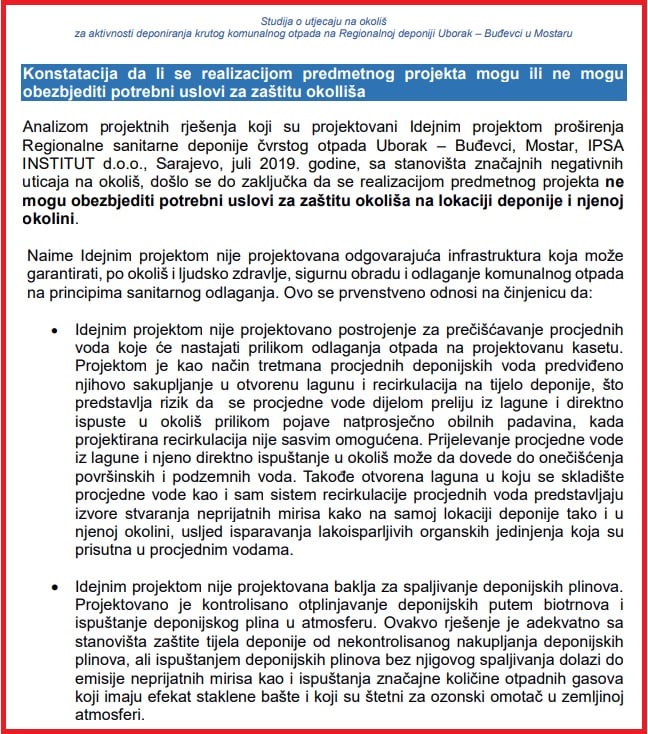
“Wherever they excavated soil or took groundwater samples, the results indicated heavy metal pollution. There is also an issue with the main pump that supplies the City of Mostar with water, located just 1.2 kilometers from the landfill. All the runoff from the landfill that passes through the groundwater eventually reaches this pump, meaning we are drinking water contaminated with heavy metals,” said Hujdur, emphasizing that the water has never been tested for heavy metals.
The Federation Ministry of Environment and Tourism told Žurnal that they issued the most recent environmental permit by a decision dated January 16 of this year. However, the Citizens’ Association “Jer nas se tiče” has filed a lawsuit with the Cantonal Court in Sarajevo to annul that decision.
“By the decision of the Cantonal Court in December 2023, the case was returned for review. In accordance with the law and the court’s decision, this Ministry is currently conducting an administrative procedure”, said the Federation Ministry.
The Citizens’ Initiative further explains that the environmental permit was annulled by the court, after which the City of Mostar resubmitted the request and repeated the process. They also note that, in the meantime, the Federation Inspectorate issued a decision prohibiting the disposal of waste at this landfill, a decision that has not been respected.
In July of this year, a contract was signed between the Federation Ministry of Environment and Tourism and the City of Mostar for the financing of the project “Construction of a Plant for the Treatment of Leachate from the Solid Waste Disposal Site at the Existing Uborak Regional Landfill in Mostar”. The news about the signing of the contract between Federation Minister of Environment and Tourism Nasiha Pozder and the Mayor of Mostar, Mario Kordić, was published on the City of Mostar’s website. The minister stated that the issue of the Uborak landfill is important for both the city and the broader community, expressing satisfaction that positive progress would finally be made. City Mayor Kordić noted that this step is the first prerequisite for the closure of the site.
The Federation Ministry has committed to paying 366.000 BAM to the City of Mostar, with the funds allocated for construction works and technological equipment. At the same time, the City of Mostar has agreed to implement the project within two years from the date of signing the contract.
“A total of 188.000 BAM was paid into the City of Mostar’s account on September 9 of this year, and the remaining funds will be disbursed according to the schedule outlined in the contract," said the Federation Ministry. They further emphasized that, within their competencies, they aim to assist and support realistic and feasible solutions, which require agreement among various levels of government, particularly with the local community.
“It is noteworthy mentioning that the updated and current Waste Management Adaptation Plan for the Uborak-Buđevci Regional Landfill in Mostar includes the remediation of existing areas and their greening. This will also be prioritized and actively pursued in the coming period. During the closure of the existing areas, the Plan envisions opening a new area for waste disposal until final rehabilitation and closure”, said the Federation Ministry. They added that it is impossible to develop an ad hoc, quick solution to eliminate all the problems that have accumulated over time, and that the only viable solutions are those that are implemented step by step, in accordance with existing legal regulations and court rulings on the matter.
The residents who have been warning all levels of government about the problems with the Uborak landfill for years do not share the opinion of the Federation Ministry. They emphasize that waste disposal at this location should be completely banned, and that a new, suitable location or alternative methods of waste disposal should be found.
“Citizens are always the ones who suffer”, concludes Omer Hujdur.
EACH CITIZEN GENERATES AN AVERAGE OF 352 KG OF WASTE ANNUALLY
By definition, illegal landfills are long-term waste disposal sites located in areas not intended for that purpose. They are most often found in remote locations, such as creek coves (due to human habits), along riverbanks, in forests, or beside roads.
The exact number of illegal landfills in Bosnia and Herzegovina is unknown, as it constantly changes and depends on the methodology used, points out Safet Kubat from the Eco Movement Rivers of Bosnia and Herzegovina – Be the Change.
“We can determine the number of illegal landfills based on mapping methodologies. According to data from 2022, there were more than 1.200, but I believe that number has decreased significantly since then. It is essential to establish a unified register of illegal landfills. A few years ago, the Agency for the Sava River Basin also conducted mapping, which determined that there were 750”, says Kubat.
The Eco Movement mapped illegal landfills in the Zavidovići area, where there were previously around 200. Currently, there are 22 illegal landfills remaining. According to Safet Kubat, this decrease in the number of illegal landfills is the result of active engagement and involvement from the local population.
To clarify, he states that each resident of Bosnia and Herzegovina produces an average of 352 kilograms of waste per year. Given that around 80 percent of the population is included in the legal waste collection system, this means that their waste ends up in regulated landfills, which are properly permitted.
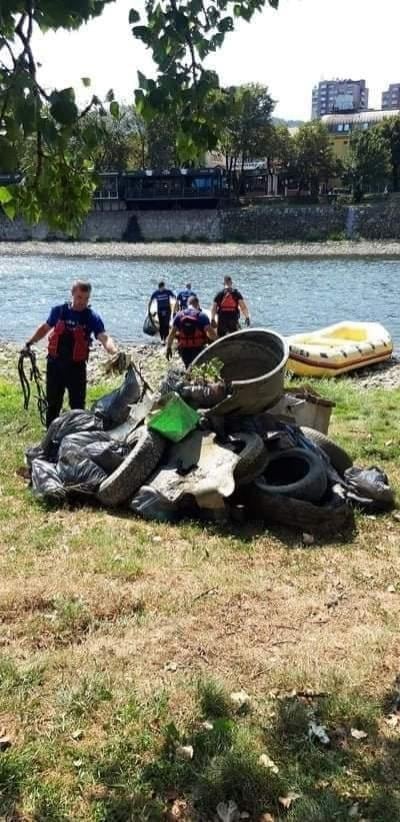
Photo: Eco Movement of the Rivers of Bosnia and Herzegovina–Be the Change
“If we assume that Bosnia and Herzegovina has a population of around 3 million, then 20% of that number—approximately 600.000 people—do not use official waste collection systems. When we multiply 600.000 inhabitants by the average waste production of 350 kg per person, we arrive at a total of 211.200 tons of waste that does not end up in legal landfills. The real question is: where does this waste end up? Given the large number of operators for different types of waste, these figures reveal the true extent of the situation we are facing,” Kubat points out.
When it comes to waste management, Kubat says the biggest challenges in the future will be related to areas where landfills have been built above populated areas or in close proximity to water sources. Such locations pose a serious threat to both the environment and human health.
According to Kubat, the process of regionalizing landfills in Bosnia and Herzegovina has not yet fully taken off. He cites Zenica as a positive example, where six surrounding municipalities now deposit their waste at the regional landfill in Mošćanica, which represents significant progress.
“It is not possible to generalize the situation across the country. We cannot, therefore, speak of the most endangered areas in broad terms, but we can say that Višegrad is particularly threatened by the accumulation of garbage coming from Serbia and Montenegro. During heavy rains, the garbage from the riverbanks washes into the river and ends up in the reservoir at the Višegrad Hydro Power Plant (HPP) on the Drina River. The garbage even threatens the operation of the HPP, as paradoxical as it may sound. In Zenica, on the other hand, we can talk about the problem of the Rača landfill, where waste has been deposited for years. Hectares of garbage, predominantly industrial waste (slag), have been brought in, and it still poses a danger to the city today,” concludes Kubat.
He also mentioned Modriča and the Tar Pit. It is important to recall that the media has been reporting for years about the toxic waste from the Modriča Oil Refinery, with a settlement located just ten meters away. In August of this year, a fire broke out in the Tar Pit, and environmentalists have long warned that it represents an ecological time bomb.
Kubat also highlighted the issue at the Nedići landfill in Breza, where illegal waste disposal by the municipality has been a persistent problem.
“Nearby was the water source Milkino Vrelo, the city road, and the Stavnja River, all of which contributed to the spread of infection. However, thanks to the goodwill and cooperation of the city authorities, the landfill was removed, the waste is now being transported directly to the regional landfill, and remediation efforts are underway,” he said.
Kubat reminds us that there are various types of waste, impacting locations accordingly
“Rarely does anyone mention waste, mine tailings, or, for example, from Autoceste—especially now that Autoceste have been exempt from Federation jurisdiction and transferred to local jurisdiction in terms of tailings. Animal waste is also a significant problem, particularly near developed meat industries. Municipal waste, which is predominantly produced by citizens, pollutes rivers, water, soil, and forests, posing a threat to human health. Although it is less common than before, it is still present, especially around the Bosna River, along its banks,” says Kubat.
RAČA LANDFILL
The Rača landfill spans approximately 700.000 square meters and was in operation for several decades, serving as a disposal site for metal waste from the Zenica steel factory, now ArcelorMittal Zenica. Over the years, many residents of Zenica conducted small-scale excavations at the site, collecting metal waste to sell as scrap metal.
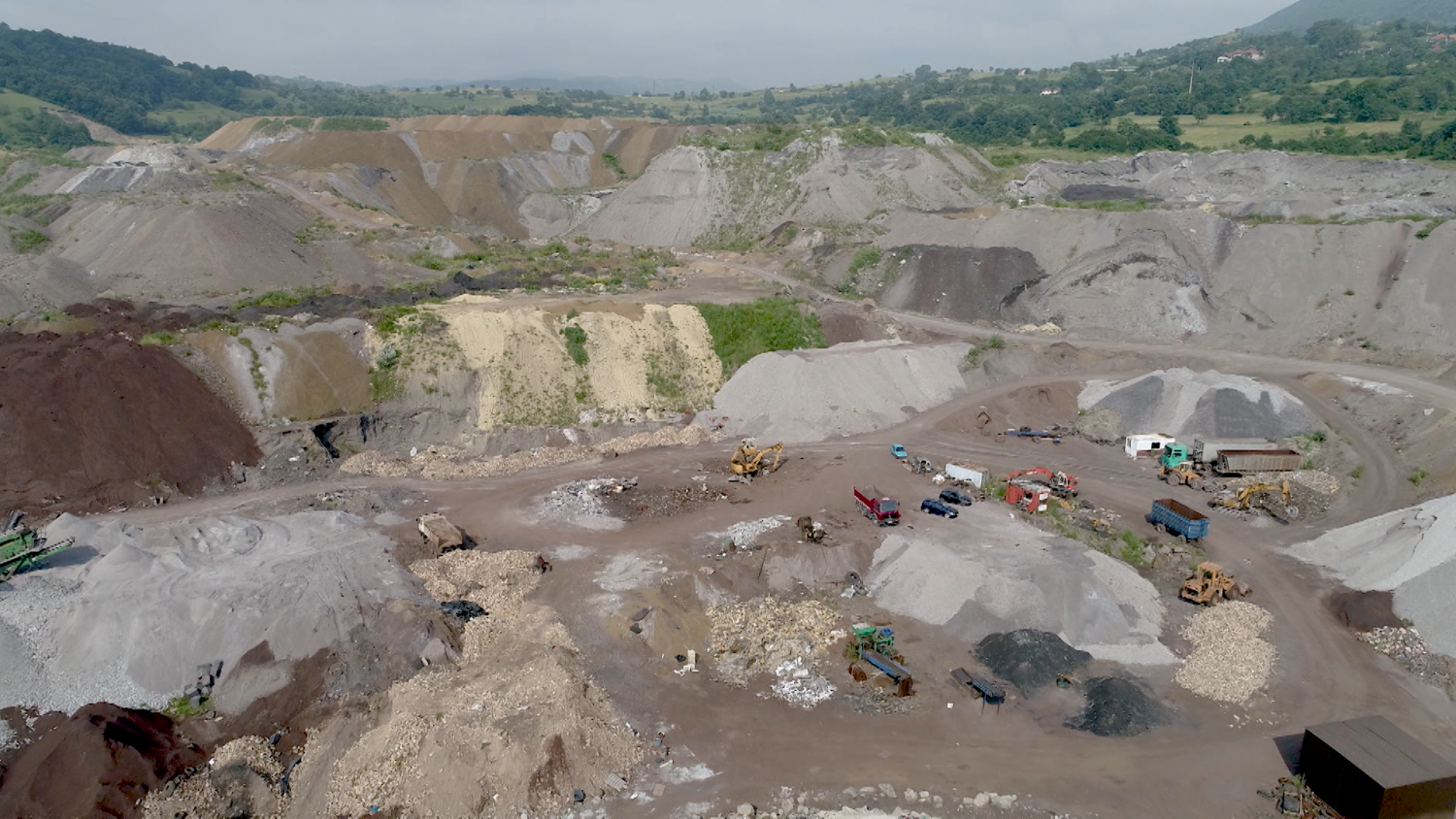
Samir Lemeš from the Eco Forum Zenica tells Žurnal that the situation with the Rača landfill is quite complex. He reminds us that in its application for the renewal of the environmental permit, ArcelorMittal stated that it had stopped disposing of new waste at the location and that the landfill would no longer be used.
In this context, Lemeš points to the recommendations and measures outlined in the application for the renewal of the environmental permit for ArcelorMittal plants and facilities, submitted in July 2022. The application includes, among other things, a statement that “the environmental impact assessment study should be carried out, and a decision should be obtained to approve the Environmental Impact Assessment Study for the cessation of operations and closure of the Rača industrial landfill”. It further notes that all necessary measures should be taken to avoid the risk of environmental pollution and to restore the site to the legally prescribed environmental condition, as outlined in the Environmental Impact Assessment Study and the plan for closure activities and procedures following the landfill’s closure.

However, the report on inspection supervision clearly reveals that the measures specified by the company were never implemented.
“Between May 1, 2023, and November 30, 2023, 11 inspections were carried out to monitor the implementation of the measures outlined in the current environmental permit for ArcelorMittal d.o.o. Zenica. During these inspections, deviations from the set deadlines and the planned timeline were noted”, reads the report from the Federation environmental protection inspector.
The report also states, among other things, that “the environmental impact assessment procedure and the decision on the closure of the Rača landfill were not carried out, and no actions were taken to mitigate the risk of pollution or environmental damage, nor to restore the site in accordance with the aforementioned legal obligations.”
In addition, the inspection report notes that after visiting several waste disposal locations, it was found that "slag from the Steel Plant is still being disposed of at the TGA landfill, which had previously been sanctioned as a site requiring special disposal procedures due to the volume of waste. Furthermore, a landfill containing an unknown but significant amount of construction waste was found at the location between the Agglomeration and the biochemical plant.”
It is also noted that slag from the VP disposal site near “beaching” is occasionally removed and sent to contracted customers, while the VP slag from the warehouse “near Kovačnica” has been cleared, with fractions of hardened steel slag now being deposited in its place.
Samir Lemeš refers to ArcelorMittal’s letter to the Federation Ministry, dated July 23 of this year, in which they requested permission to continue using the Rača site, claiming they have no other alternatives. The Ministry had asked for additional information to supplement the request, but to date, no response has been received from ArcelorMittal.
““They also requested that their waste be classified as a by-product to avoid waste regulations. As a result, they don't have a permit, and the waste is disposed of by whoever shows up, including Mittal,” said Lemeš.
ILLEGAL LANDFILLS ALSO POLLUTE WATER
Safet Kubat emphasizes that illegal landfills have a detrimental impact on the air, water, forests, soil, and ecosystems as a whole, affecting both humans and animals. Illegal landfills are often the primary source of drinking water contamination in local water facilities through leachate.
“More than 80 percent of drinking water samples in Zenica-Doboj Canton fail microbiological tests, which is directly linked to fecal bacteria commonly associated with illegal landfills, as well as sewage systems,” says Kubat.
He also points out that wild landfills have a negative impact on tourism, damaging the image of cities and the entire country. Kubat further explains that these illegal landfills affect river flows and contribute to air pollution, as they are highly flammable.
“They can often lead to methane explosions, and the burning of landfills poses a significant environmental and health risk to the population, warranting severe criminal penalties,” emphasizes Kubat. He added that illegal landfills also directly impact public health, particularly in terms of infections.
LANDFILL FIRES
For the past 15 years or so, the Stanovi landfill in Kladanj has been a focal point of concern. In early August of this year, a fire broke out at the landfill, which smoldered for several days. As a result, the Civil Protection Headquarters of the Municipality of Kladanj declared a state of natural disaster.
Adi Selman from the “Cardboard Revolution” movement tells Žurnal that the landfill operates without any permits or the necessary conditions for legal operation, yet the public utility enterprise from Kladanj continues to dispose of waste there. He also reminds that the process of building a regional landfill in Banovići began in 2014, a project that will serve the municipalities of Kladanj and Živinice. This project is now in its final phase, after more than 10 years of development.
It is noteworthy mentioning that the media had in July reported on a fire at the Višnjik landfill in Gradačac, where the blaze spread to nearby wheat fields and a forest, moving toward residential areas. As a result, the Civil Protection issued a warning to citizens, advising them to stay indoors due to the health risks posed by the smoke.
The Center for and Energy has also been warning about the dangers of fires at landfills. The Center previously stated that, in the event of a fire at a landfill, it is impossible to determine the exact composition of the gases produced. However, it is clear that these gases are highly toxic and often carcinogenic, with serious health risks for both the surrounding population and those involved in firefighting efforts.
PROBLEMS OF RESIDENTS IN ŽUNOVNICI
Residents of the Žunovnici settlement in the Hadžići municipality have contacted the newsroom of Žurnal, complaining about the construction waste that has been stored in the Žunovnica barracks for years. In February of this year, Jazid Bajrić from Naša stranka (Our Party) also highlighted that the barracks in Hadžići has become the largest illegal garbage dump in Canton Sarajevo, where waste has been dumped for several years and is now being leveled with excavators to conceal the environmental disaster.
“It is essential to address the landfill issue and urgently initiate actions aimed at improving the quality of life for residents,” states a post on the website of Naša stranka.
However, according to the Cantonal Administration for Inspection Affairs of Canton Sarajevo, no request for inspection at this location has been submitted for some time. At the same time, the Cantonal Administration reports that an inspection was conducted in September 2023 regarding the non-maintenance of the plot and the improper disposal of waste at the Technical and Repair Institute (TRZ) in Hadžići.
“Acting within their powers and responsibilities, inspection reports were compiled, which noted that, at the time of the inspection, construction waste was present on the Institute’s premises. This waste had been generated during the rehabilitation and reconstruction of buildings at the site. In this regard, the subject of the inspection was instructed to dispose of the waste at recycling yards in Smiljevići, Novo Sarajevo, and Ilijaš. Additionally, the Institute was warned that the wood waste, which is used as an energy source for the thermal energy production, should be stored in covered areas or adequately protected from the elements,” stated the Cantonal Administration for Inspection Affairs of Canton Sarajevo.
They further state that during the inspection, the acting municipal inspector was provided with evidence of the formation of a commission to oversee the cleanup of the waste dumped at the TRZ site. Additionally, documentation was presented showing that efforts had been initiated to transfer the construction waste to an authorized company for proper disposal. The inspector was also shown invoices for the purchase of scrap metal, sawdust, and secondary raw materials, which are typically purchased by waste management companies.
MANAGEMENT QUALITY OF SO-CALLED SANITARY LANDFILLS IS QUESTIONABLE
Igor Kalaba from the Center for the Environment recalls the performance audit report “Functioning of the Municipal Waste Management System”, published in October 2023. The report states that illegal landfills are “out of control” and pose significant risks to human health and safety.
“The report estimates that there are around 270 illegal landfills in Republika Srpska. While this number is already alarming, the situation may in fact be even worse. Additionally, it should be noted that the management quality of most so-called sanitary landfills is highly questionable, which calls into question the very definition of what constitutes a wild landfill,” says Kalaba.
The Center has repeatedly reported on illegal and inadequate landfills across the country, from Omačina to Drvar.
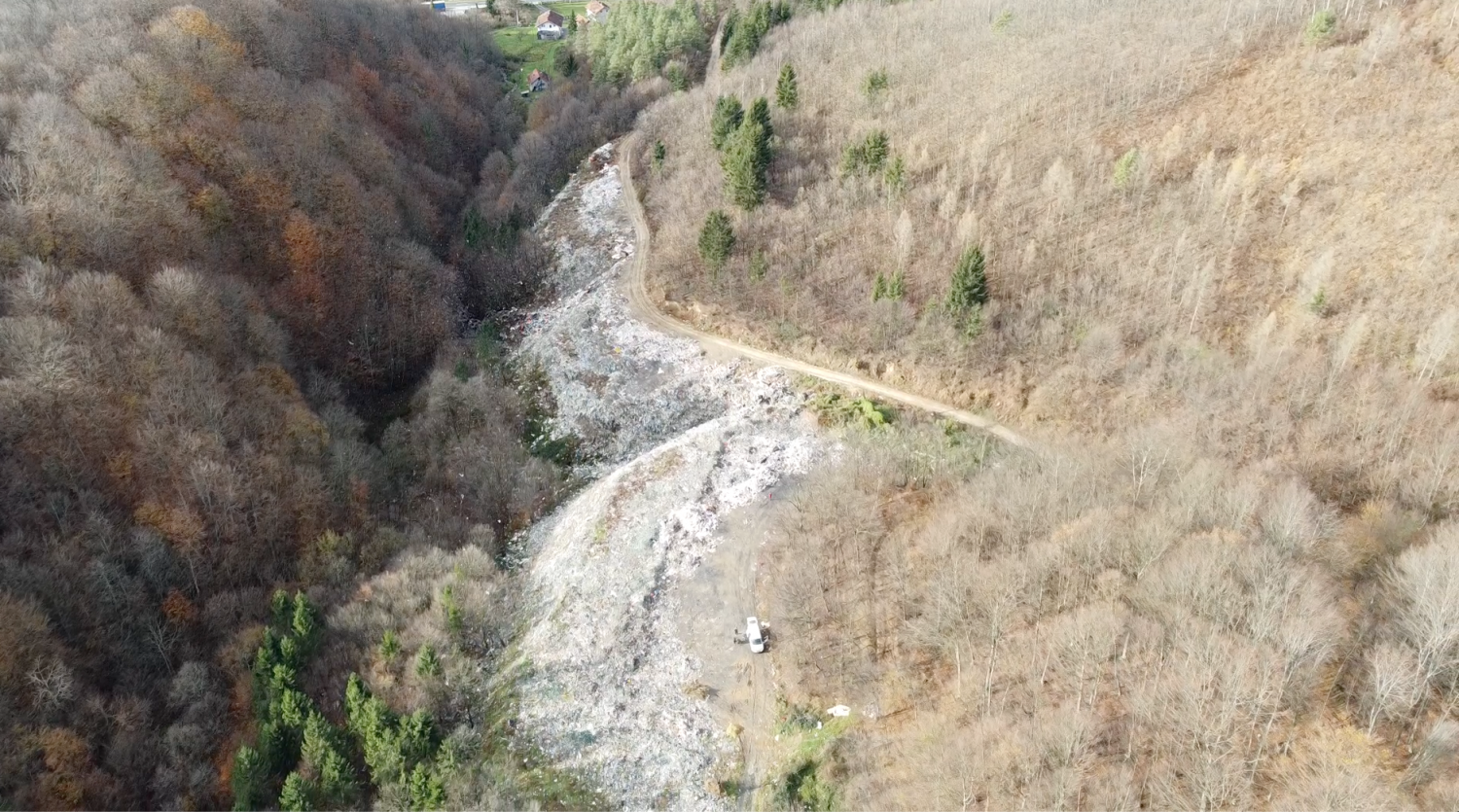
“In some cases, smaller illegal landfills are cleaned up by utility services. However, unless proper waste management systems are established at these or nearby locations, the problem often recurs. The bigger issue lies with large, illegal, and temporary landfills, which are often inadequate municipal landfills. These require significant investment to address, and a long-term solution can only be achieved through a systemic change in waste management,” Kalaba added.
The biggest problem, he added, is with municipal waste, though inadequate disposal of construction waste is also a frequent issue.
Igor Kalaba explains that health and environmental risks depend on the type of waste involved. In some cases, toxic substances such as asbestos are present. With municipal waste, the consequences include the proliferation of rats, the gathering of stray dogs, and, since slaughterhouse waste is often disposed of improperly, the potential outbreak and spread of infectious diseases. Depending on the location, it’s not uncommon for landfills to be situated along riverbanks, which can lead to the pollution of watercourses.
“There is always some responsibility on the competent authorities, but also on the citizens. However, citizens cannot be held fully accountable in cases where they lack the infrastructure to dispose of waste legally. The aforementioned report states that around 30 percent of citizens in RS are not covered by a waste collection and disposal system. On the other hand, if both temporary and permanent landfills are inadequate, what distinguishes them from illegal landfills? What incentive do citizens have to act responsibly when they know their waste will likely be disposed of improperly? Furthermore, while inspection services cannot resolve the problem directly, their role is crucial. They are responsible for warning, sanctioning, and performing their duties professionally and persistently, as they are an important link in the path toward a final solution,” Kalaba points out.
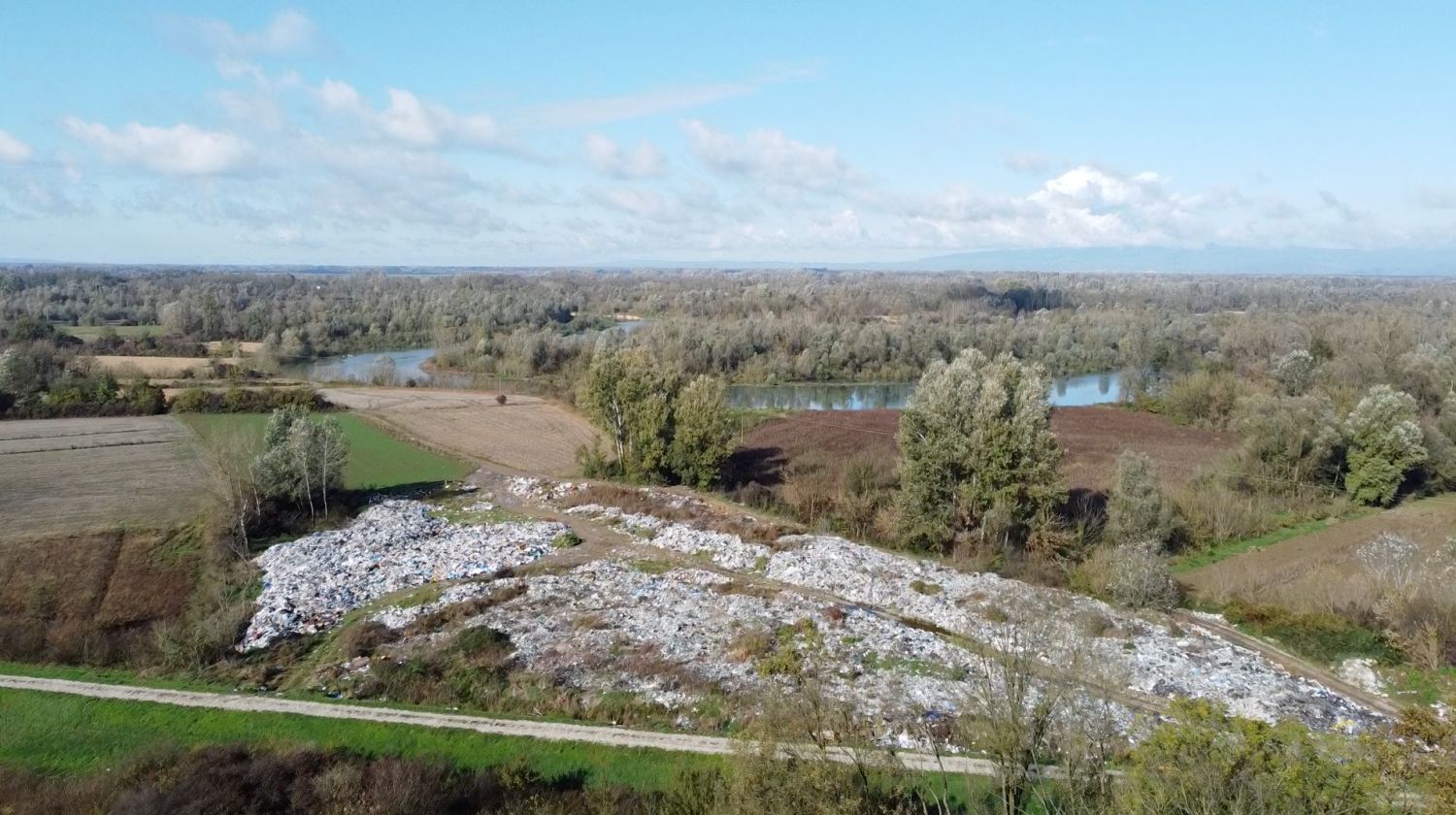
HOW TO PUN AN END TO ILLEGAL LANDFILLS
Igor Kalaba asserts that a long-term solution to the waste problem requires ambitious, systemic policies that establish a proper hierarchy of waste management. This hierarchy should prioritize the most sustainable and environmentally acceptable measures, with less acceptable options being reduced to an absolute minimum.
“The key step is to reduce waste production across all sectors and responsibly manage what is generated. This includes maximizing the use and collection of reusable materials—through re-use and upcycling—followed by recycling, and only as a last resort, disposal in landfills.
It is crucial to provide the necessary infrastructure to support these measures, but equally important is actively working to raise citizens' awareness. However, this must be done in this particular order, not the other way around,” Kalaba concludes.
Safet Kubat emphasizes that there is no “magic wand” to solve environmental problems, only systemic solutions. He recalls the numerous initiatives and actions undertaken by the ecological movement Rivers of Bosnia and Herzegovina “Be the Change”. This eco-movement has organized more than 3.600 garbage clean-up events.
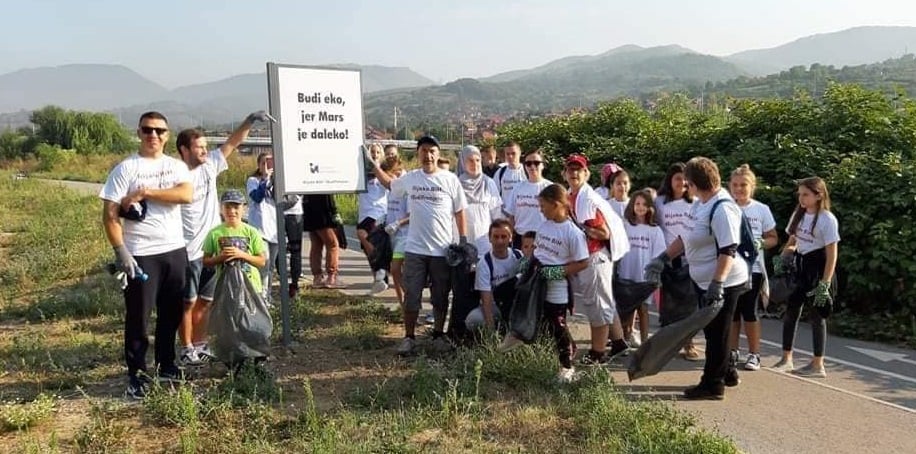
“Our efforts are directed in two ways: one towards institutions, investors, and legal entities, and the other towards citizens. We have also worked on raising environmental awareness, and I can confidently say that the situation has improved significantly,” says Kubat.
He mentions Zenica-Doboj Canton as an example where waste removal has increased from 75 to almost 95 percent, marking a significant shift. According to Kubat, there has also been progress in Sarajevo Canton, particularly in the past two years.
“People are much more aware now, but we still face challenges with about 10 percent of the population. We need to address the issue of riverbanks, which requires systemic solutions starting with involving the population in waste removal, followed by on-site waste separation, an increased rate of recycling, and better waste utilization. Concrete solutions are needed, leading up to the introduction of a deposit system like those in Germany, Croatia, Great Britain, Estonia, and other countries,” says Kubat.
(zurnal.info)





